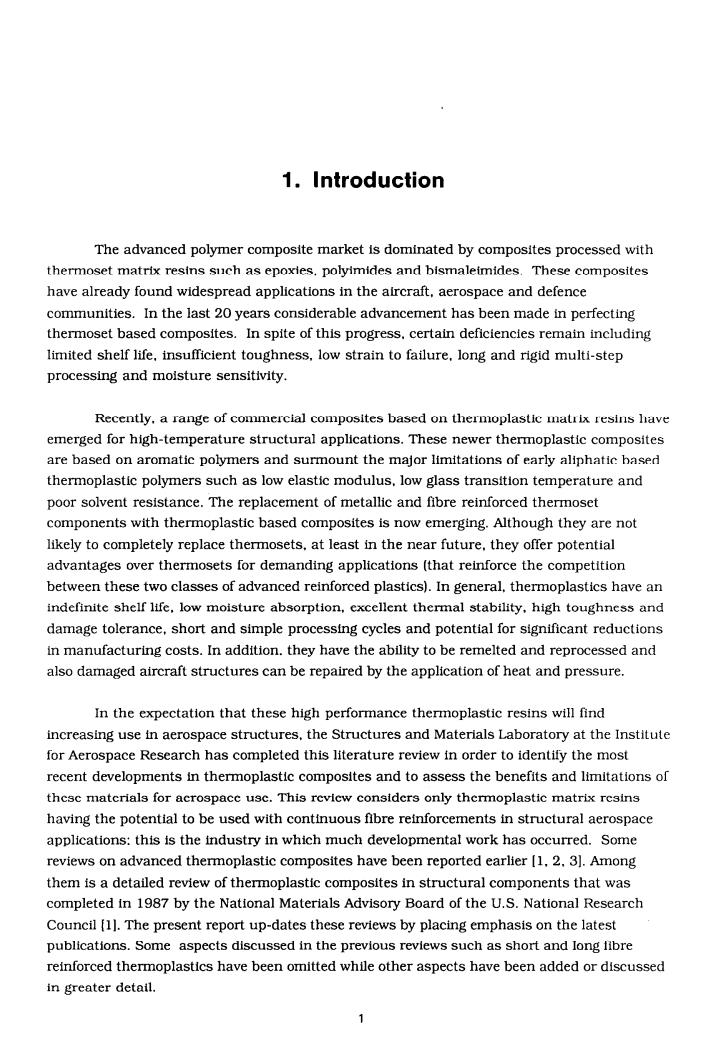正在加载图片...

1.Introduction The advanced polymer composite market is dominated by composites processed with thermoset matrix resins such as epoxies.polyimides and bismaleimides.These composites have already found widespread applications in the aircraft,aerospace and defence communities.In the last 20 years considerable advancement has been made in perfecting thermoset based composites.In spite of this progress.certain deficiencies remain including limited shelf life,insufficient toughness.low strain to failure,long and rigid multi-step processing and moisture sensitivity. Recently.a range of commercial composites based on thermoplastic matrix resins have emerged for high-temperature structural applications.These newer thermoplastic composites are based on aromatic polymers and surmount the major limitations of early aliphatic based thermoplastic polymers such as low elastic modulus,low glass transition temperature and poor solvent resistance.The replacement of metallic and fibre reinforced thermoset components with thermoplastic based composites is now emerging.Although they are not likely to completely replace thermosets,at least in the near future,they offer potential advantages over thermosets for demanding applications(that reinforce the competition between these two classes of advanced reinforced plastics).In general,thermoplastics have an indefinite shelf life.low moisture absorption,excellent thermal stability,high toughness and damage tolerance,short and simple processing cycles and potential for significant reductions in manufacturing costs.In addition.they have the ability to be remelted and reprocessed and also damaged aircraft structures can be repaired by the application of heat and pressure. In the expectation that these high performance thermoplastic resins will find increasing use in aerospace structures,the Structures and Materials Laboratory at the Institute for Aerospace Research has completed this literature review in order to identify the most recent developments in thermoplastic composites and to assess the benefits and limitations of thesc matcrials for acrospacc usc.This revicw considers only thermoplastic matrix rcsins having the potential to be used with continuous fibre reinforcements in structural aerospace applications:this is the industry in which much developmental work has occurred.Some reviews on advanced thermoplastic composites have been reported earlier [1.2.3].Among them is a detailed review of thermoplastic composites in structural components that was completed in 1987 by the National Materials Advisory Board of the U.S.National Research Council [1l.The present report up-dates these reviews by placing emphasis on the latest publications.Some aspects discussed in the previous revlews such as short and long libre reinforced thermoplastics have been omitted while other aspects have been added or discussed in greater detail. 11. Introduction The advanced polymer composite market is dominated by composites processed with thermoset matrix resins such as epoxies, polyimides and bismaleimides. These composites have already found widespread applications in the aircraft, aerospace and defence communities. In the last 20 years considerable advancement has been made in perfecting thermoset based composites. In spite of this progress, certain deficiencies remain including limited shelf life, insufficient toughness, low strain to failure, long and rigid multi-step processing and moisture sensitivity. Recently, a range of commercial composites based on thermoplastic matrix resins have emerged for high-temperature structural applications. These newer thermoplastic composites are based on aromatic polymers and surmount the major limitations of early aliphatic based thermoplastic polymers such as low elastic modulus, low glass transition temperature and poor solvent resistance. The replacement of metallic and fibre reinforced thermoset components with thermoplastic based composites is now emerging. Although they are not likely to completely replace thermosets, at least in the near future, they offer potential advantages over thermosets for demanding applications (that reinforce the competition between these two classes of advanced reinforced plastics). In general, thermoplastics have an indefinite shelf life, low moisture absorption, excellent thermal stability, high toughness and damage tolerance, short and simple processing cycles and potential for significant reductions in manufacturing costs. In addition, they have the ability to be remelted and reprocessed and also damaged aircraft structures can be repaired by the application of heat and pressure. In the expectation that these high performance thermoplastic resins will find increasing use in aerospace structures, the Structures and Materials Laboratory at the Institute for Aerospace Research has completed this literature review in order to identify the most recent developments in thermoplastic composites and to assess the benefits and limitations of these materials for aerospace use. This review considers only thermoplastic matrix resins having the potential to be used with continuous flbre reinforcements in structural aerospace applications; this is the industry in which much developmental work has occurred. Some reviews on advanced thermoplastic composites have been reported earlier [ 1, 2. 31. Among them is a detailed review of thermoplastic composites in structural components that was completed in 1987 by the National Materials Advisory Board of the U.S. National Research Council (11. The present report up-dates these reviews by placing emphasis on the latest publications. Some aspects discussed in the previous reviews such as short and long fibre reinforced thermoplastics have been omitted while other aspects have been added or discussed in greater detail